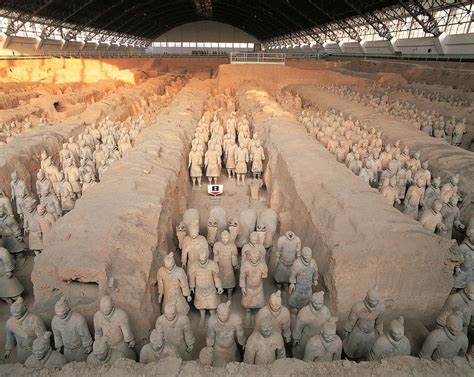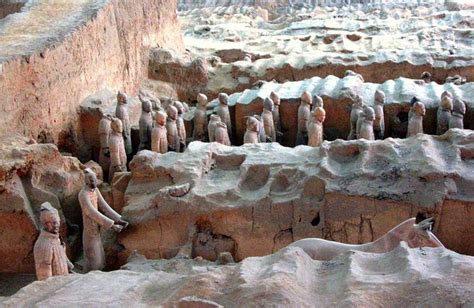why won't china excavate the emperors tomb The 2,200-year-old burial place of Qin Shi Huang, the ancient emperor who unified China, has not been opened out of fear of dangerous traps and mercury. Scientists have . Hire quality diggers for projects in Cambridgeshire, we have micro, mini and midi diggers available from £55 a day. Contact us today! . We offer a variety of diggers for hire, including mini, midi, .
0 · why china tomb is open
1 · why are china's tomb so invasive
2 · why are china's tomb ruined
3 · china tomb problems
4 · china tomb opening
5 · china emperor tomb
6 · china emperor mausoleum
7 · china 1st emperor tomb
Discover 4,930 New & Used Other Plant Machinery For Sale in Ireland on .
A prime reason behind this hesitancy is that archeologists are concerned about how the excavation might damage the tomb, losing vital historical information. Currently, only invasive. Learn the reasons why the underground palace of the First Qin Emperor remains unexcavated, such as limited technology, deep depth, long time, and environmental risk. Find . The 2,200-year-old burial place of Qin Shi Huang, the ancient emperor who unified China, has not been opened out of fear of dangerous traps and mercury. Scientists have . Death traps and mercury poisoning are just some of the concerns facing archaeologists contemplating excavating Qin Shi Huang's tomb, China's first emperor. In 1974, .
why china tomb is open
why are china's tomb so invasive
Historical records indicate that the emperor, who unified China from 221 BC to 210 BC, consumed mercury in his quest for eternal life. Recent studies in 2020 confirmed . Archaeologists are too scared to open up the 2,200-year-old tomb of China's first emperor Qin Shi Huang because they fear it might harbor deadly booby traps. The mausoleum . They have legitimate concerns about exploring the tomb. Archaeologists haven’t dared look inside the tomb of China’s first Emperor. Chances are you’re aware of Qin Shi .
Despite being engaged in one of the biggest archaeological discoveries of all time, the tomb of China’s first emperor, Qin Shi Huang, remains mostly shut off and undiscovered by .
The first Emperor of China, Qin Shi Huang, was buried in a mausoleum with rare artefacts and deadly crossbows in 210BCE. Learn about the history, legends and challenges .The mausoleum of Qin Shi Huang, the first emperor of the Qin dynasty, is a large tomb complex with a pyramid-shaped mound and a necropolis of terracotta soldiers. It is a UNESCO World . A prime reason behind this hesitancy is that archeologists are concerned about how the excavation might damage the tomb, losing vital historical information. Currently, only invasive.
volvo telescoping skid steer
why are china's tomb ruined

vertical skid steer wood splitter
Learn the reasons why the underground palace of the First Qin Emperor remains unexcavated, such as limited technology, deep depth, long time, and environmental risk. Find out what is buried inside the mausoleum and how to visit the terracotta warriors pits. The 2,200-year-old burial place of Qin Shi Huang, the ancient emperor who unified China, has not been opened out of fear of dangerous traps and mercury. Scientists have proposed using muons, a non-invasive technique, to explore the tomb without damaging it. Death traps and mercury poisoning are just some of the concerns facing archaeologists contemplating excavating Qin Shi Huang's tomb, China's first emperor. In 1974, farmers stumbled upon. Historical records indicate that the emperor, who unified China from 221 BC to 210 BC, consumed mercury in his quest for eternal life. Recent studies in 2020 confirmed unnaturally high mercury levels within the tomb, aligning with ancient chronicle records.
Archaeologists are too scared to open up the 2,200-year-old tomb of China's first emperor Qin Shi Huang because they fear it might harbor deadly booby traps. The mausoleum of the.
They have legitimate concerns about exploring the tomb. Archaeologists haven’t dared look inside the tomb of China’s first Emperor. Chances are you’re aware of Qin Shi Huang’s final resting place, even if you’ve never heard of him. He was the first person to rule unified China and reigned from 221BC to 210BC. Despite being engaged in one of the biggest archaeological discoveries of all time, the tomb of China’s first emperor, Qin Shi Huang, remains mostly shut off and undiscovered by archaeologists and historians. The first Emperor of China, Qin Shi Huang, was buried in a mausoleum with rare artefacts and deadly crossbows in 210BCE. Learn about the history, legends and challenges of opening his tomb, which has remained sealed for over 2000 years.
The mausoleum of Qin Shi Huang, the first emperor of the Qin dynasty, is a large tomb complex with a pyramid-shaped mound and a necropolis of terracotta soldiers. It is a UNESCO World Heritage Site and a cultural symbol of ancient China. A prime reason behind this hesitancy is that archeologists are concerned about how the excavation might damage the tomb, losing vital historical information. Currently, only invasive. Learn the reasons why the underground palace of the First Qin Emperor remains unexcavated, such as limited technology, deep depth, long time, and environmental risk. Find out what is buried inside the mausoleum and how to visit the terracotta warriors pits.
china tomb problems
The 2,200-year-old burial place of Qin Shi Huang, the ancient emperor who unified China, has not been opened out of fear of dangerous traps and mercury. Scientists have proposed using muons, a non-invasive technique, to explore the tomb without damaging it.
Death traps and mercury poisoning are just some of the concerns facing archaeologists contemplating excavating Qin Shi Huang's tomb, China's first emperor. In 1974, farmers stumbled upon.
Historical records indicate that the emperor, who unified China from 221 BC to 210 BC, consumed mercury in his quest for eternal life. Recent studies in 2020 confirmed unnaturally high mercury levels within the tomb, aligning with ancient chronicle records.
Archaeologists are too scared to open up the 2,200-year-old tomb of China's first emperor Qin Shi Huang because they fear it might harbor deadly booby traps. The mausoleum of the. They have legitimate concerns about exploring the tomb. Archaeologists haven’t dared look inside the tomb of China’s first Emperor. Chances are you’re aware of Qin Shi Huang’s final resting place, even if you’ve never heard of him. He was the first person to rule unified China and reigned from 221BC to 210BC. Despite being engaged in one of the biggest archaeological discoveries of all time, the tomb of China’s first emperor, Qin Shi Huang, remains mostly shut off and undiscovered by archaeologists and historians.
The first Emperor of China, Qin Shi Huang, was buried in a mausoleum with rare artefacts and deadly crossbows in 210BCE. Learn about the history, legends and challenges of opening his tomb, which has remained sealed for over 2000 years.
volvo tracked skid steer specs

Rotobec offers a range of mini power attachments for mini excavators, including grapples, buckets and limb reapers. These attachments enhance the performance and versatility of mini excavators with Rotobec's toughness and innovation.
why won't china excavate the emperors tomb|china emperor mausoleum